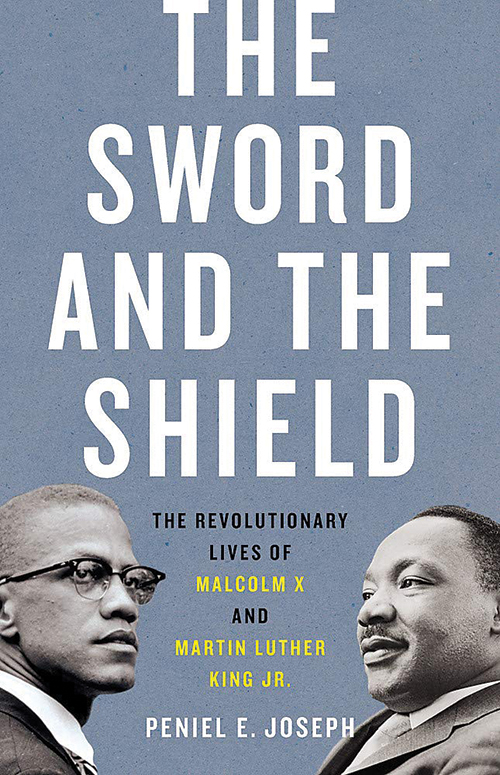
The Sword and the Shield: The Revolutionary Lives of Malcolm X and Martin Luther King Jr.
Reviewed by J. E. McNeil
October 1, 2021
By Peniel E. Joseph. Basic Books, 2020. 384 pages. $30/hardcover; $18.99/paperback; $19.99/eBook.
Living through a historic era is no guarantee of understanding it. In 2000, when I first read Martin Luther King Jr.’s April 4, 1967 “Beyond Vietnam” speech given at Riverside Church in New York City, I saw a side of King I had never seen before: radical, antiwar, and anti-capitalism.
Peniel E. Joseph’s dual biography of Martin Luther King Jr. and Malcolm X throws light on the real men and their relationship, which shaped their legacies of continuing struggles after their martyrdom. The book opens at a critical point for the United States, the Civil Rights Movement, and for the lives of Martin and Malcolm. The Civil Rights Act of 1964 was on the Senate floor, supported by Republicans and opposed by filibusters by Southern Democrats. Both Martin and Malcolm came to lobby for its passage. Martin was still on a crest from his “I Have a Dream” speech at the March on Washington the summer before and was afforded some insider privilege. Malcolm, recently having split from the Nation of Islam, which forbade political activities among its members, sought political leverage and stature as a leader of a large number of Blacks around the country and the world. Malcolm met Martin in the hall after Martin’s press conference—the only time they ever met.
The initial awkwardness of their meeting gave way to a rapport aided by a mutual understanding of black culture, their shared role as political leaders who doubled as preachers, and the rhythms of a common love for black humanity and yearning for black citizenship. Martin and Malcolm would never develop a personal friendship, but their political visions would grow closer together throughout their lives. . . . [T]heir relationship, even in that short meeting, defies the myths about their politics and activism.
The myth of Malcolm as the “evil twin” of Martin, the nonviolent advocate of racial equality with no economic component, endures. So does the myth of Malcolm as an “any means necessary” advocate for Black nationalism with no willingness to compromise.
Joseph tells their individual stories and their story together. They met by proxy over the years through Friend Bayard Rustin; Congress of Racial Equality (CORE) leader James Farmer; John Lewis, Julian Bond, and Stokely Carmichael of Student Nonviolent Coordinating Committee (SNCC); and others. Through these proxy debates and public pronouncements, “they were each building—both consciously and unconsciously—a public persona that served as a response to the other.” In the meanwhile, the predominately White press repeatedly ignored Martin’s more “radical pronouncements in [his] discussion . . . in favor of a more polished narrative of quietly determined moral leadership.” And they repeatedly framed Malcolm as only saying radical, militant things.
Showing a more complete story of each of these men, this account neither views Martin through rose-colored glasses nor Malcolm through a glass darkly. The homophobia of the Civil Rights Movements (since there was not just one movement) is touched on lightly in regards to Rustin. The sexism of both Martin and Malcolm is touched on in some depth, including Malcolm’s shifting attitude toward women in the last year of his life through his connections with SNCC. It’s a narrative of maneuvering, rivalry, and brotherhood, and a recasting of stories we think we know by heart. We are given peeks at the stories of Rustin, Ella Baker, Coretta Scott King, and others rising in prominence (or working behind the scenes) at the time. When King was in jail in 1964 in Selma, Malcolm came to speak.
Sitting on the dais next to Coretta, Malcom relayed a message that caught her off guard. “Mrs. King, . . . I want [Martin] to know that I didn’t come [to Selma] to make his job more difficult. I thought that if the white people understood what the alternative was that they would be willing to listen to Dr. King.”
There are minor factual lapses in the book—Fellowship of Reconciliation was founded in 1915 during World War One rather than World War Two. The Quaker faith of Bayard Rustin is ignored as it is in so many civil rights histories now that Rustin himself is no longer ignored for being gay. But these are small things. I would welcome future work from Joseph, exploring the stories of Rustin and Baker, other civil rights heroes who have been given little attention. With his generally accurate pen, Joseph could do some of the lesser-known figures justice, and readers real benefit.
Both leaders were assassinated, but the reaction was different. Though philosophically they had become very close—albeit approaching their positions from different directions—in death they were both simplified beyond recognition. The creation of the King holiday may have solidified Martin as a “founding father” and racial equality as a fundamental right, but Martin’s and Malcolm’s fight for economic justice was lost.
Martin and Malcolm “sought a moral and political reckoning with America’s long history of racial and economic injustice”—a reckoning that has yet to come. This book helps reframe the discussion and look toward the solution.
J. E. McNeil is a sixth-generation Southerner who grew up in Texas during the 1950s and ’60s. A particular point of pride for her is that in 1979 her late brother, Malcolm Bruce McNeil, helped draft the very first bill to make Juneteenth an official holiday while working for Al Edwards, the Texas State Representative from Houston.


